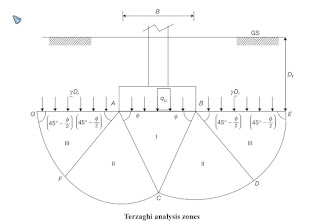Most Important theories
used in soil mechanics as engineer
Boussinesq Theory: for stress strain relationship, due to a point load on surface:
- The Boussinesq method on Soil Mechanics uses the theory of elasticity to calculate the vertical stress under a point load in a homogeneous, semi-infinite half space its assumptions is very important for civil engineers to remember for solving many important civil engineering problems
- The stresses within a semi-infinite, homogeneous, isotropic mass, with a linear stress–
strain relationship, due to a point load on the surface, were determined by Boussinesq
in 1885
Assumptions consider on Boussinesq theory
- Soil is Homogeneous and Isotropic, Semi-infinite and elastic.
- Soil is Fully Saturated means Presence of zero air voids.
- Soil is Initially unstressed.
- Stress Distribution diagram about vertical axis is symmetrical.
- Any Change in volume of Soil due to Load is Neglected.
- Hooks law is Valid.
- Self weight of soil is neglected.
Equations
`\sigma=\frac{3Q}{2\pi z^2}\left[\frac1{1+\left(\frac rz\right)^2}\right]^\frac{5}{2}`
The vertical, radial, circumferential and shear stresses at a depth z and a horizontal distance r from the point of application of the load in boussinesq theory on soil mechanics
Kb is known as influence factor
Westergaard Theory
Assumptions of Westergaard Theory for soil mass in civil engineering
- Soil is Homogeneous and Isotropic and Elastic.
- Soil is consider as Cohesive like- clay.
- Soil profile is Layered.
- Here, μ= Poisson's Ratio. If Poisson's Ratio is considered zero for all practical purposes
Equations
- `\sigma_z=\frac{Q}{\pi z^2}\left[\frac1{1+2\left(\frac rz\right)^2}\right]^\frac{3}{2}`
- `\sigma_z=\frac Q{z^2}I_w`
- Where, Q is the point load and σz is the vertical stress due to the point load,
- `I_w=\frac1\pi\left[\frac1{1+2\left(\frac rz\right)^2}\right]^\frac3{2}`
\sigma=\frac{Q}{\pi z^2}\left[\frac1{1+2\left(\frac rz\right)^2}\right]^\frac{3}{2}`
Coulomb's Theory of Earth Pressure on Retaining wall
- Coulomb’s theory (1776) involves consideration of the stability, as a whole, of the wedge of soil between a retaining wall and a trial failure plane.
- The force between the wedge and the wall surface is determined by considering the equilibrium of forces acting on the wedge when it is on the point of sliding either up or down the failure plane, i.e. when the wedge is in a condition of limiting equilibrium
Assumptions of Coulomb's Theory of Earth Pressure for determining
- Soil mass is Homogeneous,Dry and Isotropic and ideally plastic.
- Back-fill is ideally plastic material and dry.
- Back-fill is cohesion-less like - Sand.
- Back of the wall surface is rough means frictional retaining wall and inclined
- The sliding Wedge itself act as a rigid body. i.e the equilibrium of the whole of the material.
- The Coulomb's theory is now interpreted as an upper bound plasticity solution
Terzaghi Theory or Terzaghi’s Bearing Capacity Theory
Assumptions
- Soil is Homogeneous and Isotropic.
- Soil is fully Saturated.
- Soil is considered as Hydrodynamic clay.
- No soil consolidation.
- Foundation is very Rigid.
- No applied Moment present.
- Soil is In-compressible.
- One dimensional flow.
- Darcy law is valid.
- Strain is small.
- No Sliding occur.
In other words of Terzaghi’s Bearing Capacity Theory
- 1. Footing base is rough and is laid at a shallow depth (i.e., D f < B).
- 2. The shear strength of soil above the base of footing is neglected. The soil above the base is replaced by a uniform surface, g D f .
- 3. The load on the footing is vertical and uniformly distributed.
- 4. Footing is long, i.e., L/B ratio is infinite, where B is width and L is the length of the footing.
- 5. Shear strength of soil is governed by Mohr–Coulomb equation.
Zones: Zone I is elastic zone, zone II is radial shear zone and zone III is passive zone.
Rankine's Theory of Earth Pressure
Rankine’s theory (1857) considers the state of stress in a soil mass when the condition of plastic equilibrium has been reached.i.e. when shear failure is on the point of occurring throughout the mass.
Assumptions
- Soil is Homogeneous and Isotropic and
- semi-infinite mass of soil with a horizontal surface
- Consider Back of the wall is Friction-less or smooth.and vertical.
- in other word having a vertical boundary formed by a smooth wall surface extending to semi-infinite depth.
- Back-fill is dry and cohesion-less.
- Critical Shear surface is Plane.
- Back-plane is vertical and smooth like no friction.
- Wall is Infinitely Long.
- No strain condition occur.
- Failure type sliding failure.
- Resultant Force is not parallel to Back-fill Surface.
- When the horizontal stress becomes equal to the passive pressure the soil is said to be inthe passive Rankine state
- The Mohr circle representing the state of stress at failure in a two-dimensional element
- The soil element is in state of plastic equilibrium. i.e in the verge of failure.
- The theory satisfies the conditions of a lower bound plasticity solution















0 Comments: